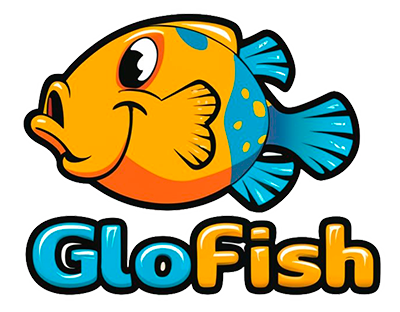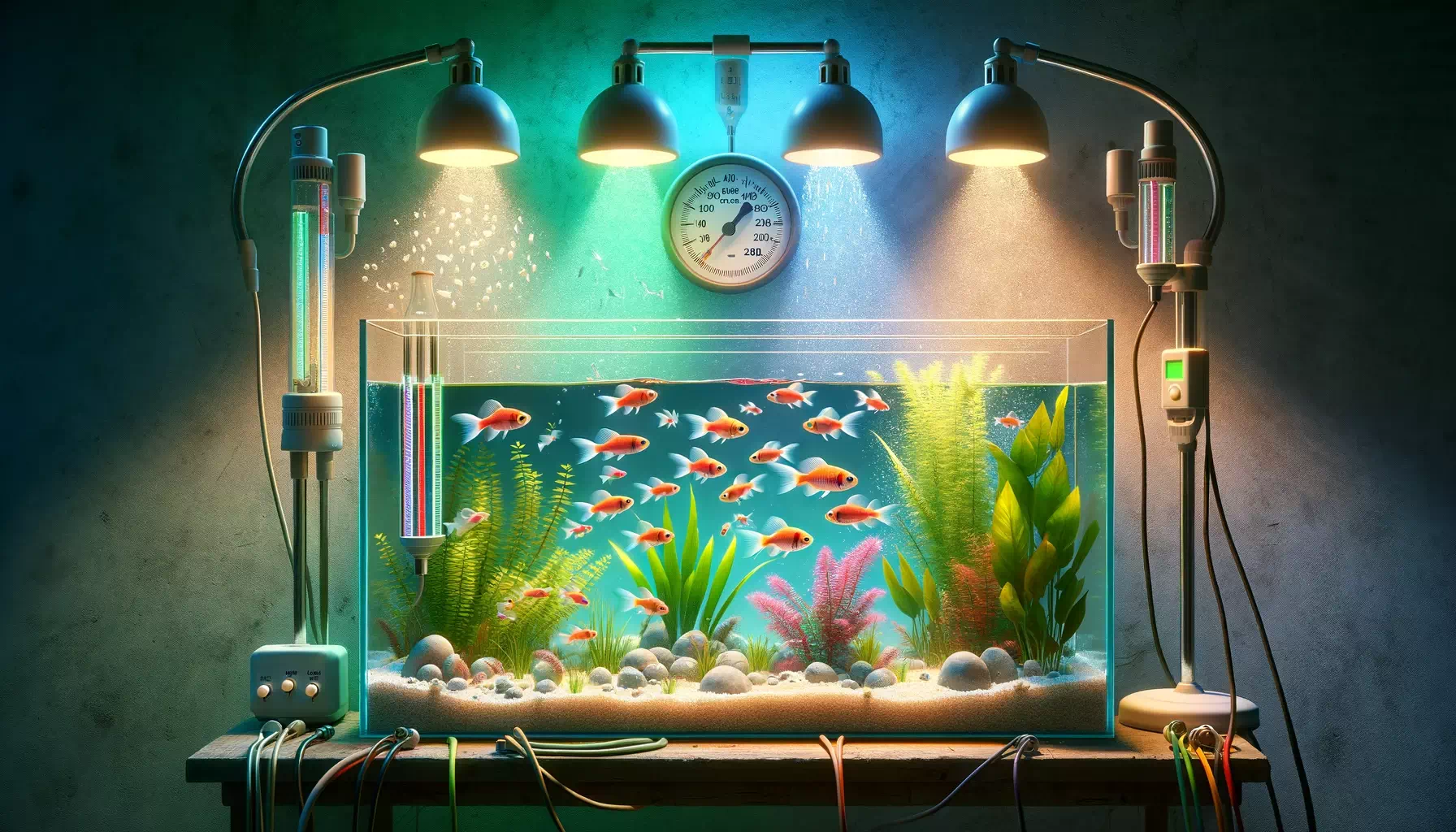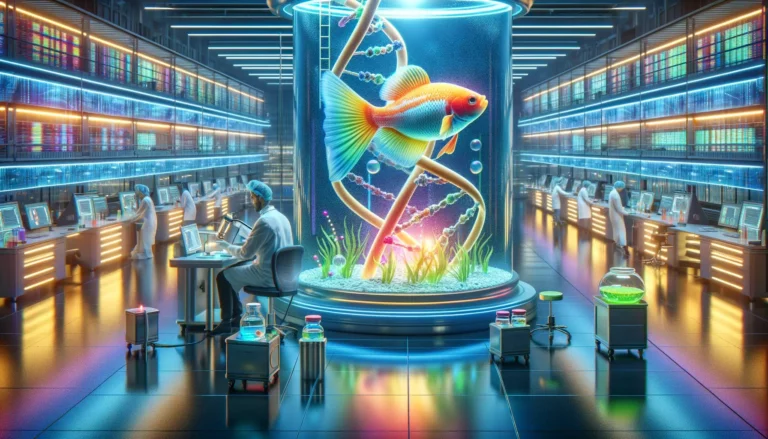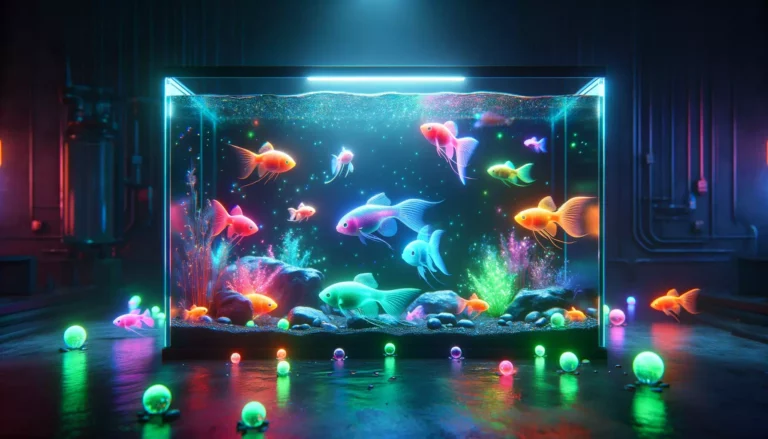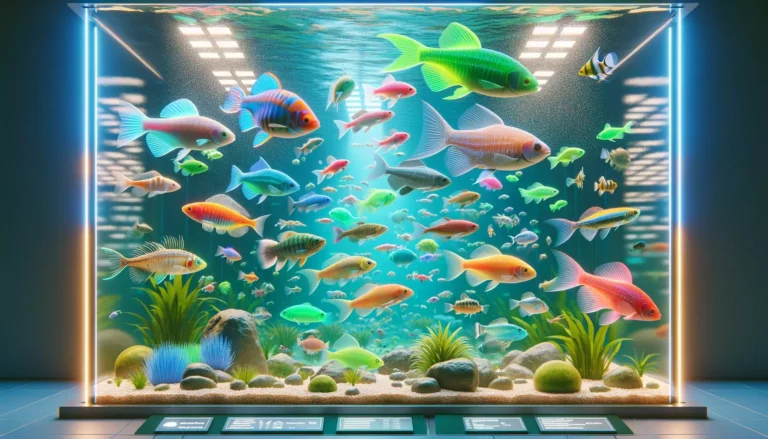Behavioral traits of different GloFish species
GloFish are fascinating for their vivid colors and unique glow. But their social structures vary significantly among species. For instance, some GloFish, like the Zebra Danio, are highly social and thrive in groups. They often swim together, showing a fascinating display of synchronized movement. This communal living helps them feel secure and reduces stress.
On the other hand, certain species, like the GloFish Betta, are more solitary. These fish are territorial and may show aggression towards their kind. They prefer living alone to maintain peace in the tank. For beginners, understanding these differences is crucial when setting up an aquarium.
Mixing social and solitary species can lead to stress and conflict. To avoid this, research each species’ needs before introducing them to your tank. For a harmonious tank, group social GloFish together and keep solitary ones separate. This understanding ensures a healthy and vibrant aquarium environment.
Influence of Environmental Factors on GloFish Behavioral Traits
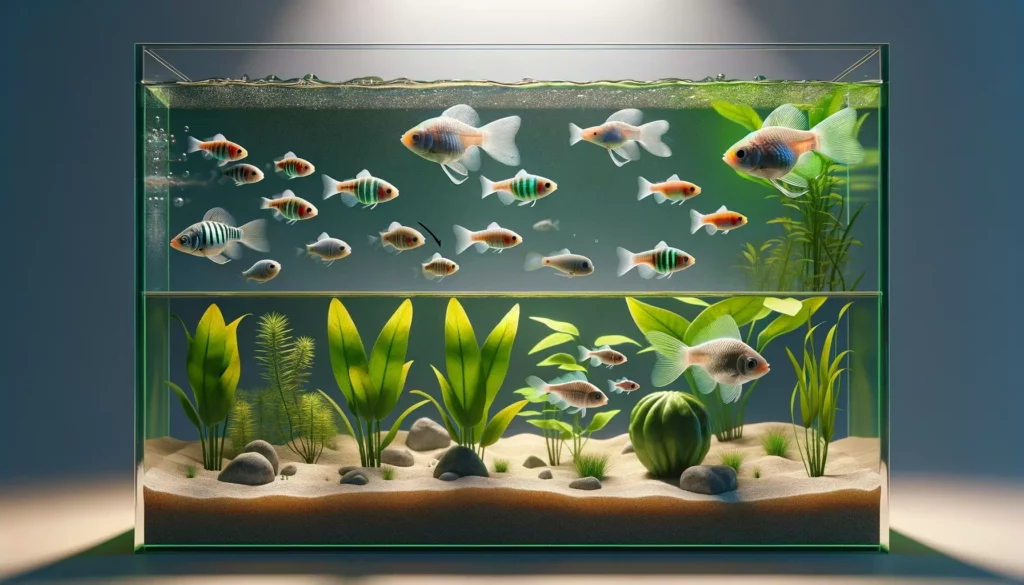
GloFish are not just about bright colors; their behavior is equally intriguing. Environmental factors like water temperature, lighting, and tank decoration play a significant role in their behavior. For instance, GloFish are sensitive to water temperature. Ideal temperatures vary between species, but generally, they thrive in warmer waters. Too cold or too hot, and you’ll notice changes in activity levels or eating habits.
Lighting is another critical factor, especially for GloFish. They need specific light conditions to show their best colors. But it’s not just about aesthetics. The right lighting also affects their mood and activity levels. Too bright or too dim, and they might become stressed or inactive.
Tank decorations also impact their behavior. GloFish enjoy environments that mimic their natural habitat. They appreciate plants, rocks, and hiding places. These features provide comfort and reduce stress. Without them, GloFish may feel exposed and become anxious.
For beginners, remember these key environmental factors. Keeping the right conditions ensures your GloFish stay healthy, active, and vibrant.
Comparative Analysis of Mating Behaviors in Different GloFish Species
Mating behaviors in GloFish are as diverse as their colors. Each species has unique courtship rituals and practices. GloFish Danios, for instance, display energetic courtship dances. Males chase females in a playful, zigzag pattern. This ritual is a fascinating display of their natural behavior.
GloFish Tetras have a subtler approach. Their mating involves gentle nipping and chasing. It’s less vigorous than Danios but equally captivating. Observing these rituals can be a delight for any aquarist.
In contrast, GloFish Bettas have a more complex ritual. Males build bubble nests as part of their courtship. They entice females to lay eggs underneath. This behavior reflects their intricate nature in the wild.
Understanding these differences is vital. It helps in providing the right environment for breeding. For beginners, observing these behaviors can be educational and enjoyable. It adds another layer of interest to the GloFish keeping experience.
Interactions Between GloFish and Non-GloFish in Shared Habitats
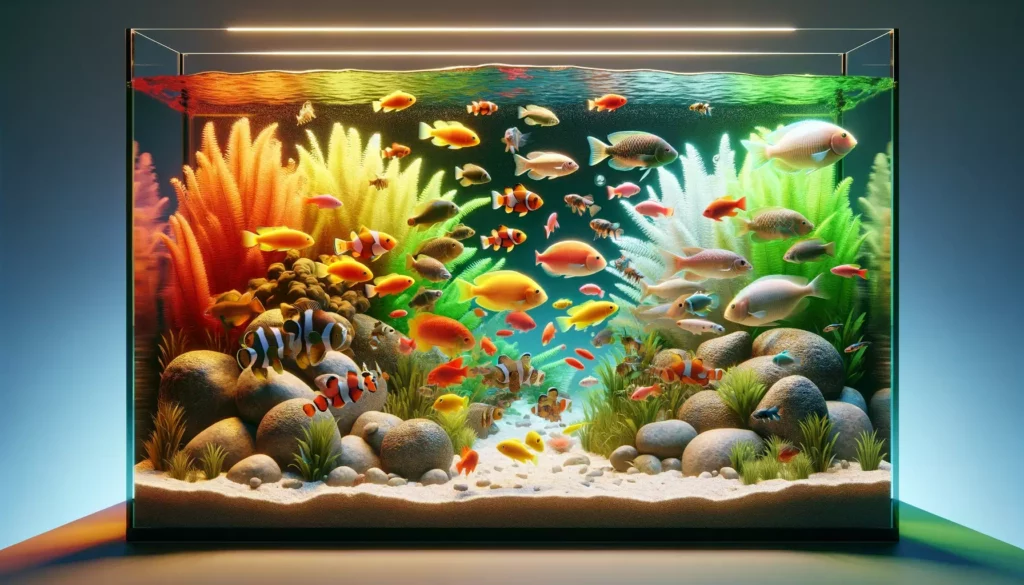
Mixing GloFish with non-GloFish can be tricky but rewarding. Each species reacts differently in shared habitats. Understanding these dynamics is key for a harmonious aquarium. GloFish are generally peaceful but some species can be territorial.
For example, GloFish Danios coexist well with many non-GloFish species. They are active and sociable. But they need space for their energetic swimming. Crowded conditions can lead to stress and aggression.
GloFish Bettas, however, are more solitary. They prefer not sharing their space. In mixed tanks, they might become stressed or aggressive. Selecting tank mates for Bettas requires careful consideration.
Tank size and decorations play a crucial role. They provide hiding spots and reduce stress. Plants, rocks, and caves help maintain peace in a mixed-species tank.
For beginners, research is vital before mixing species. Understanding each fish’s nature ensures a healthy, vibrant community. It prevents conflicts and creates a thriving ecosystem in your tank.
Dietary Preferences and Feeding Behaviors in Various GloFish Species
GloFish, like their non-genetically modified counterparts, have diverse dietary preferences. Each GloFish species has unique nutritional requirements. For instance, GloFish Danios are omnivores. They enjoy a mix of plant-based and meaty foods. Quality flake food, along with occasional brine shrimp, keeps them healthy.
| GloFish Species | Dietary Preferences | Recommended Foods | Feeding Habits |
|---|---|---|---|
| GloFish Danios | Omnivores | Quality flake food, occasional brine shrimp | Surface and mid-level feeders |
| GloFish Tetras | Carnivores | Small pellets, daphnia, frozen foods | Mid-level and bottom feeders |
| GloFish Bettas | Protein-rich diet | Special betta pellets, occasional bloodworms | Surface and mid-level feeders |
GloFish Tetras, on the other hand, lean towards carnivorous diets. They thrive on high-protein foods. Small pellets, daphnia, or frozen foods are perfect for them. It’s important to ensure these foods are small enough for them to eat.
GloFish Bettas require a diet rich in proteins. Special betta pellets are ideal. They mimic the insect-based diet Bettas would have in the wild. Occasional treats like bloodworms are also beneficial.
Feeding habits vary among species. Some prefer surface feeding, while others feed at mid-level or bottom. Observing your GloFish during feeding helps in understanding their preferences. For beginners, it’s crucial to feed the right amount. Overfeeding can lead to health issues and tank pollution.
Behavioral Indicators of Health Issues and Stress in GloFish
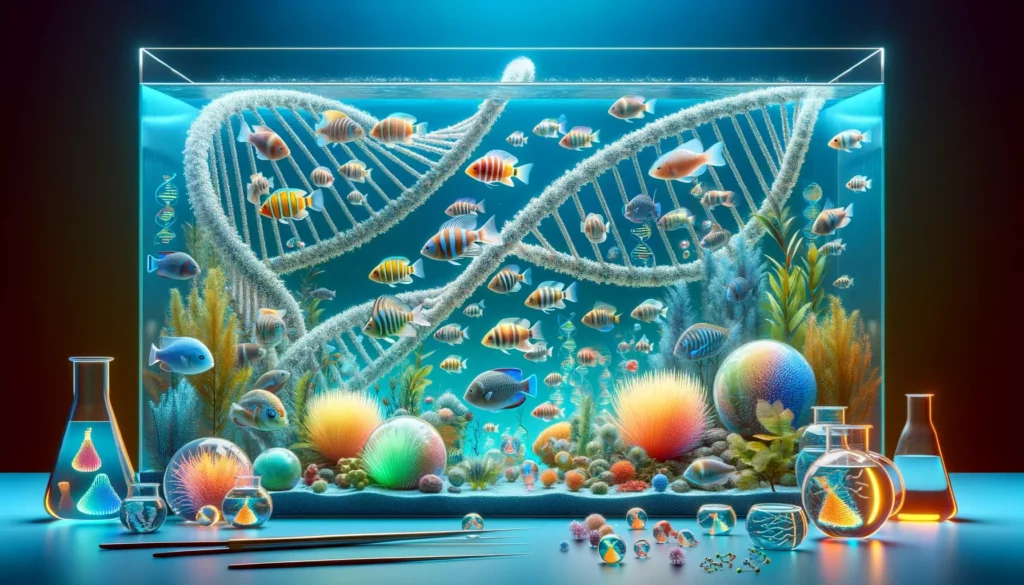
Behavioral changes in GloFish often signal health issues or stress. Recognizing these signs is essential for maintaining their well-being. Lethargy or reduced activity often indicates a problem. Healthy GloFish are typically active and vibrant. If they become sluggish or stop swimming much, it’s a sign of distress.
Loss of appetite is another key indicator. Healthy GloFish eagerly anticipate feeding times. If they show disinterest in food, it could suggest illness.
Aggression or hiding more than usual can also be signs of stress. This could be due to poor water quality, overcrowding, or unsuitable tank mates. Regularly check water parameters and ensure the tank isn’t overpopulated.
For beginners, observing your GloFish’s behavior is crucial. Any significant change may require attention. Consult with a vet or an experienced aquarist if you notice unusual behaviors.
Behavioral Changes Across the Lifecycle Stages of GloFish
GloFish exhibit interesting behavioral changes as they grow. From fry to adult, their behavior evolves. Young GloFish, or fry, are typically more cautious and hide more. This behavior is a natural defense mechanism. As they mature, they become more confident and active.
| Lifecycle Stage | Behavior | Characteristics |
|---|---|---|
| Fry | Cautious and Hide | Natural defense mechanism, less active |
| Juvenile | Energetic Exploration | Social hierarchies, schooling behavior (Danios, Tetras) |
| Adult | Defined Personalities | Territorial tendencies (Betta), richer colors, fins |
| Breeding | Breeding Behaviors Emerge | Vibrant males, courting females |
Juvenile GloFish display a lot of energy. They explore their environment and establish social hierarchies. In species like Danios and Tetras, this is when schooling behavior becomes pronounced.
Adult GloFish often show more defined personalities. For example, adult GloFish Bettas may become more territorial. They also display richer colors and more pronounced fins.
Breeding behaviors emerge in adult stages. Males may become more vibrant and active in courting females. For aquarists, observing these life stages offers a deeper understanding of GloFish behavior. It’s important to cater to their needs at each stage for their healthy development.
Territorial Behaviors of GloFish in Community Tank Environments
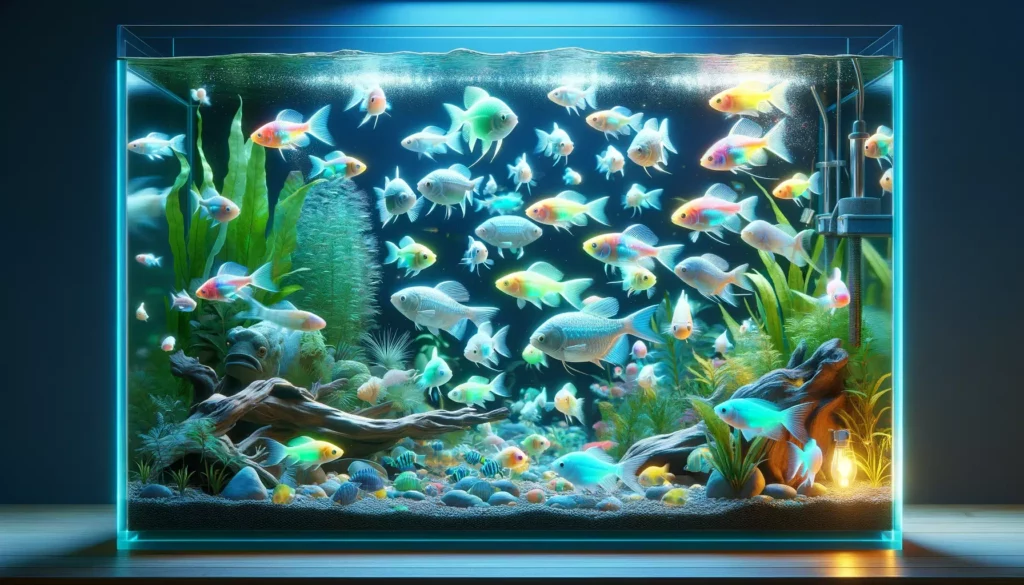
In community tanks, territorial behaviors among GloFish can significantly affect tank dynamics. Some GloFish species are more territorial than others, influencing how they coexist with tank mates. GloFish Bettas, for instance, are known for their territorial nature. They prefer to have a space of their own and can become aggressive if they feel encroached upon.
GloFish Danios and Tetras, however, are less territorial. They are more comfortable in groups and don’t typically claim specific areas in the tank. Yet, if the tank is too small or overcrowded, even these social species can exhibit territorial behaviors.
Creating a harmonious tank environment involves understanding these traits. Adequate space, hiding spots, and a well-structured environment can minimize territorial disputes. For beginners, it’s important to research and plan your tank setup. This ensures that territorial behaviors don’t lead to stress or conflict among your GloFish.
Behavioral Adaptations of GloFish to Environmental Changes
GloFish, like their natural counterparts, show remarkable adaptability to environmental changes. Their responses to these changes can be varied and fascinating. Changes in lighting, water conditions, or tank setup often trigger behavioral adaptations in GloFish. For instance, GloFish typically adjust their activity levels to changes in lighting. Brighter lights may encourage more vibrant and active behaviors, while dimmer conditions might lead to a more subdued state.
Water quality and temperature changes also have a significant impact. GloFish might become more lethargic if the water becomes too cold. Conversely, warmer temperatures might increase their metabolism and activity. Regular monitoring and gradual adjustments are key to maintaining their well-being.
Environmental enrichment, like adding plants or changing the tank’s layout, can stimulate GloFish. It encourages exploration and natural behaviors. For beginners, observing how your GloFish adapt to these changes can be both educational and engaging.
Genetic Influences on Behavioral Traits of Different GloFish Species
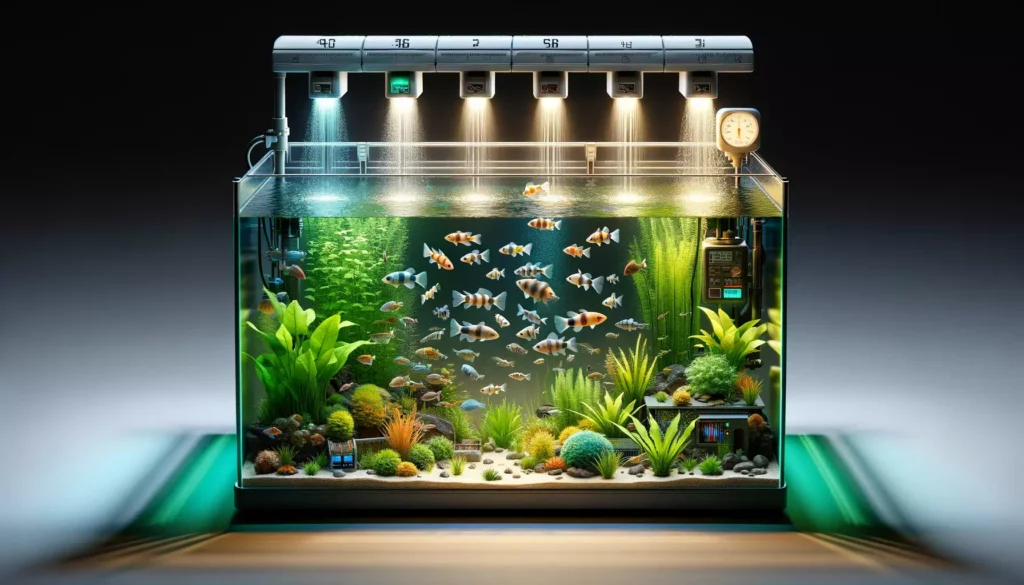
The behavior of GloFish is a complex interplay of genetics and environmental factors. Genetics play a significant role in determining the basic behavioral patterns of GloFish. Each species, due to its genetic makeup, has inherent traits. For example, GloFish Bettas are genetically predisposed to be territorial, while GloFish Danios have a natural tendency to school.
However, environmental factors can modify these genetic predispositions. The conditions in which GloFish are kept, from tank size to the social environment, can influence their behaviors. For instance, a GloFish that is genetically social may become more solitary if kept in stressful conditions.
For beginners, understanding this genetic basis is important. It helps in selecting the right species for your tank and managing their environment appropriately. However, it’s also crucial to recognize that the way you care for your GloFish can significantly influence their behavior, despite their genetic tendencies.
